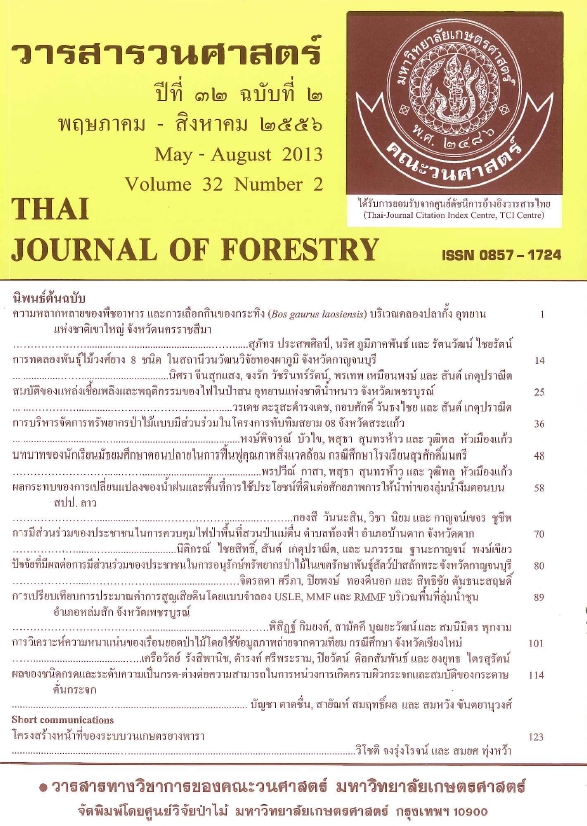การวิเคราะห์ความหนาแน่นของเรือนยอดป่าไม้โดยใช้ข้อมูลภาพถ่ายจากดาวเทียม กรณีศึกษา จังหวัดเชียงใหม่
Main Article Content
บทคัดย่อ
ความหนาแน่นเรือนยอดของป่าไม้ เป็นข้อมูลที่มีความสำคัญ บ่งบอกความอุดมสมบูรณ์ของป่าไม้และมวลชีวภาพ การศึกษาครั้งนี้มีวัตถุประสงค์ เพื่อใช้ข้อมูลภาพถ่ายจากดาวเทียม LANDSAT-5 TM ประเมินหาความหนาแน่นเรือนยอดของป่าไม้ เพื่อเปรียบเทียบความสัมพันธ์ระหว่างความหนาแน่นเรือนยอดของป่าไม้ ที่ได้จากการวิเคราะห์ข้อมูลภาพถ่ายดาวเทียมกับข้อมูลการสำรวจภาคสนามโดยใช้กล้องเลนส์ตาปลา และเพื่อจัดทำแผนที่ความหนาแน่นเรือนยอดป่าไม้ในจังหวัดเชียงใหม่การวิเคราะห์ข้อมูลภาพถ่ายจากดาวเทียม ใช้โปรแกรม FCD Mapper เพื่อคำนวณค่าดัชนี 4 ตัว ได้แก่ ดัชนีความเป็นพืชพรรณ ดัชนีความเป็นดิน ดัชนีความร้อน และดัชนีความเป็นเงาไม้ และประเมินหาความหนาแน่นเรือนยอดของป่าไม้ จากนั้นใช้สมการเส้นตรงหาความสัมพันธ์ระหว่างความหนาแน่นเรือนยอดของป่าไม้ ที่ได้จากภาพถ่ายดาวเทียมและกล้องเลนส์ตาปลา ผลการศึกษาพบว่า ข้อมูลภาพถ่ายจากดาวเทียม สามารถประเมินหาความหนาแน่นเรือนยอดของป่าไม้ได้อย่างมีประสิทธิภาพ ความหนาแน่นเรือนยอดป่าไม้ที่ได้จาก 2 วิธีไม่ต่างกัน และมีความสัมพันธ์ทางสถิติ ที่ระดับความเชื่อมั่นร้อยละ 95 มีค่าสัมประสิทธิ์ความสัมพันธ์ (coefficient of determination: R2) เท่ากับ 0.81 และนำข้อมูลจากการวิเคราะห์เรือนยอดโดยภาพถ่ายจากดาวเทียมมาจัดทำแผนที่ความหนาแน่นเรือนยอดป่าไม้ แบ่งเป็น 10 ชั้น โดยแต่ละช่วงชั้นมีร้อยละของความหนาแน่น ดังนี้ 0-10, 11-20, 21-30, 31-40, 41-50, 51-60, 61-70, 71-80, 81-90 และ 91-100 ครอบคลุมพื้นที่ร้อยละ 18.35, 5.86, 9.96, 13.31, 15.06, 14.08, 11.39, 7.71, 3.82 และ 0.46 ของพื้นที่จังหวัดเชียงใหม่ ตามลำดับ
คำสำคัญ: ความหนาแน่นของเรือนยอดป่าไม้ ข้อมูลภาพถ่ายจากดาวเทียม LANDSAT-5 TM FCD Mapper จังหวัดเชียงใหม่
Downloads
Article Details

อนุญาตภายใต้เงื่อนไข Creative Commons Attribution-NonCommercial-NoDerivatives 4.0 International License.
ข้าพเจ้าและผู้เขียนร่วม (ถ้ามี) ขอรับรองว่า ต้นฉบับที่เสนอมานี้ยังไม่เคยได้รับการตีพิมพ์และไม่ได้อยู่ในระหว่างกระบวนการพิจารณาตีพิมพ์ลงในวารสารหรือสิ่งตีพิมพ์อื่นใด ข้าพเจ้าและผู้เขียนร่วม (ถ้ามี) ยอมรับหลักเกณฑ์และเงื่อนไขการพิจารณาต้นฉบับ ทั้งยินยอมให้กองบรรณาธิการมีสิทธิ์พิจารณาและตรวจแก้ต้นฉบับได้ตามที่เห็นสมควร พร้อมนี้ขอมอบลิขสิทธิ์ผลงานที่ได้รับการตีพิมพ์ให้แก่วารสารวนศาสตร์ คณะวนศาสตร์ มหาวิทยาลัยเกษตรศาสตร์ กรณีมีการฟ้องร้องเรื่องการละเมิดลิขสิทธิ์เกี่ยวกับภาพ กราฟ ข้อความส่วนใดส่วนหนึ่ง หรือ ข้อคิดเห็นที่ปรากฏในผลงาน ให้เป็นความรับผิดชอบของข้าพเจ้าและผู้เขียนร่วม (ถ้ามี) แต่เพียงฝ่ายเดียว และหากข้าพเจ้าและผู้เขียนร่วม (ถ้ามี) ประสงค์ถอนบทความในระหว่างกระบวนการพิจารณาของทางวารสาร ข้าพเจ้าและผู้เขียนร่วม (ถ้ามี) ยินดีรับผิดชอบค่าใช้จ่ายทั้งหมดที่เกิดขึ้นในกระบวนการพิจารณาบทความนั้น”


